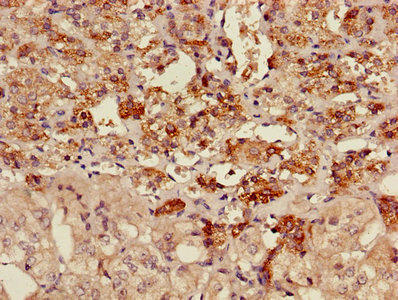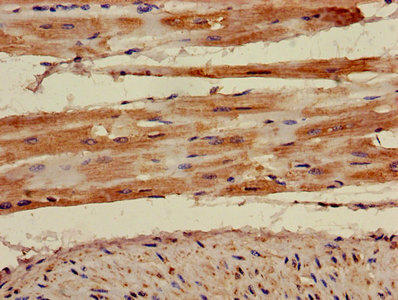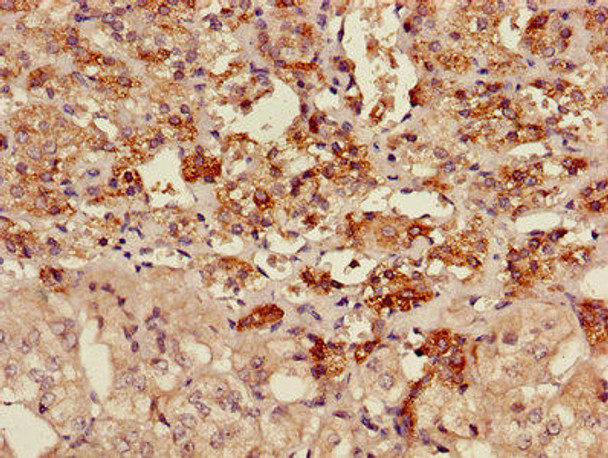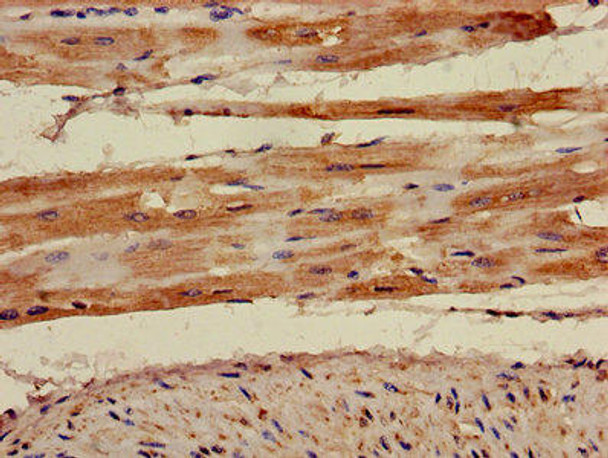Description
AKAP7 Antibody (PACO24839)
The AKAP7 Antibody (PAC024839) is a valuable tool for researchers studying AKAP7, a protein involved in cell signaling and regulation of cellular processes. This polyclonal antibody, generated in rabbits, displays high reactivity with human samples and is validated for use in Western blot applications. By binding to the AKAP7 protein, this antibody allows for precise detection and analysis in a variety of cell types, making it well-suited for investigations in cell biology and signal transduction pathways.AKAP7, also known as A-kinase anchor protein 7, is a crucial player in organizing protein complexes and facilitating cAMP-dependent signaling within cells. Its role in mediating various cellular functions, such as ion channel regulation and gene expression, underscores its importance in physiological processes and disease development.
Research on AKAP7 is essential for unraveling its functions and potential therapeutic implications in conditions like cardiovascular disease, neurological disorders, and cancer.Overall, the AKAP7 Antibody (PAC024839) offers researchers a reliable tool for exploring the intricate roles of AKAP7 in cellular signaling pathways and disease pathogenesis. Its specificity and sensitivity make it an invaluable asset for studies aiming to decipher the complexities of AKAP7-mediated processes and develop targeted interventions for related disorders.
| Antibody Name: | AKAP7 Antibody (PACO24839) |
| Antibody SKU: | PACO24839 |
| Size: | 50ug |
| Host Species: | Rabbit |
| Tested Applications: | ELISA, IHC,IF |
| Recommended Dilutions: | ELISA:1:2000-1:10000, IHC:1:20-1:200, IF:1:50-1:200 |
| Species Reactivity: | Human |
| Immunogen: | Recombinant Human A-kinase anchor protein 7 isoforms α and β protein (1-81AA) |
| Form: | Liquid |
| Storage Buffer: | Preservative: 0.03% Proclin 300 Constituents: 50% Glycerol, 0.01M PBS, PH 7.4 |
| Purification Method: | >95%, Protein G purified |
| Clonality: | Polyclonal |
| Isotype: | IgG |
| Conjugate: | Non-conjugated |
 | Immunohistochemistry of paraffin-embedded human adrenal gland tissue using PACO24839 at dilution of 1:100. |
 | Immunofluorescence staining of HepG2 cells with PACO24839 at 1:120,counter-stained with DAPI. The cells were fixed in 4% formaldehyde, permeabilized using 0.2% Triton X-100 and blocked in 10% normal Goat Serum. The cells were then incubated with the antibody overnight at 4°C.The secondary antibody was Alexa Fluor 488-congugated AffiniPure Goat Anti-Rabbit IgG (H+L). |
 | Immunohistochemistry of paraffin-embedded human heart tissue using PACO24839 at dilution of 1:100. |
| Background: | Targets the cAMP-dependent protein kinase (PKA) to the plasma membrane, and permits functional coupling to the L-type calcium channel. The membrane-associated form reduces epithelial sodium channel (ENaC) activity, whereas the free cytoplasmic form may negatively regulate ENaC channel feedback inhibition by intracellular sodium. |
| Synonyms: | A-kinase anchor protein 7 isoforms α and β (AKAP-7 isoforms α and beta) (A-kinase anchor protein 18 kDa) (AKAP 18) (Protein kinase A-anchoring protein 7 isoforms alpha/beta) (PRKA7 isoforms alpha/beta), AKAP7, AKAP15 AKAP18 |
| UniProt Protein Function: | AKAP7 iso1: Probably targets cAMP-dependent protein kinase (PKA) to the cellular membrane or cytoskeletal structures. The membrane- associated form reduces epithelial sodium channel (ENaC) activity, whereas the free cytoplasmic form may negatively regulate ENaC channel feedback inhibition by intracellular sodium. 3 isoforms of the human protein are produced by alternative splicing. |
| UniProt Protein Details: | Protein type:Adaptor/scaffold Chromosomal Location of Human Ortholog: 6q23.2 Cellular Component: cytosol Molecular Function:protein binding; protein kinase A binding Biological Process: protein localization |
| NCBI Summary: | This gene encodes a member of the A-kinase anchoring protein (AKAP) family, a group of functionally related proteins that bind to a regulatory subunit (RII) of cAMP-dependent protein kinase A (PKA) and target the enzyme to specific subcellular compartments. AKAPs have a common RII-binding domain, but contain different targeting motifs responsible for directing PKA to distinct intracellular locations. Three alternatively spliced transcript variants encoding different isoforms have been described.[provided by RefSeq, Apr 2011] |
| UniProt Code: | O43687 |
| NCBI GenInfo Identifier: | 25108878 |
| NCBI Gene ID: | 9465 |
| NCBI Accession: | O43687.4 |
| UniProt Secondary Accession: | O43687,Q5TBR9, Q5TBS0, Q9HCZ8, Q9P0G4, A8K2K6, |
| UniProt Related Accession: | Q9P0M2,O43687 |
| Molecular Weight: | 11kDa |
| NCBI Full Name: | A-kinase anchor protein 7 isoforms alpha and beta |
| NCBI Synonym Full Names: | A-kinase anchoring protein 7 |
| NCBI Official Symbol: | AKAP7 |
| NCBI Official Synonym Symbols: | AKAP15; AKAP18 |
| NCBI Protein Information: | A-kinase anchor protein 7 isoform gamma; A-kinase anchor protein 7 |
| UniProt Protein Name: | A-kinase anchor protein 7 isoforms alpha and beta |
| UniProt Synonym Protein Names: | A-kinase anchor protein 18 kDa; AKAP 18; Protein kinase A-anchoring protein 7 isoforms alpha/beta; PRKA7 isoforms alpha/beta |
| Protein Family: | A-kinase anchor protein |
| UniProt Gene Name: | AKAP7 |
















